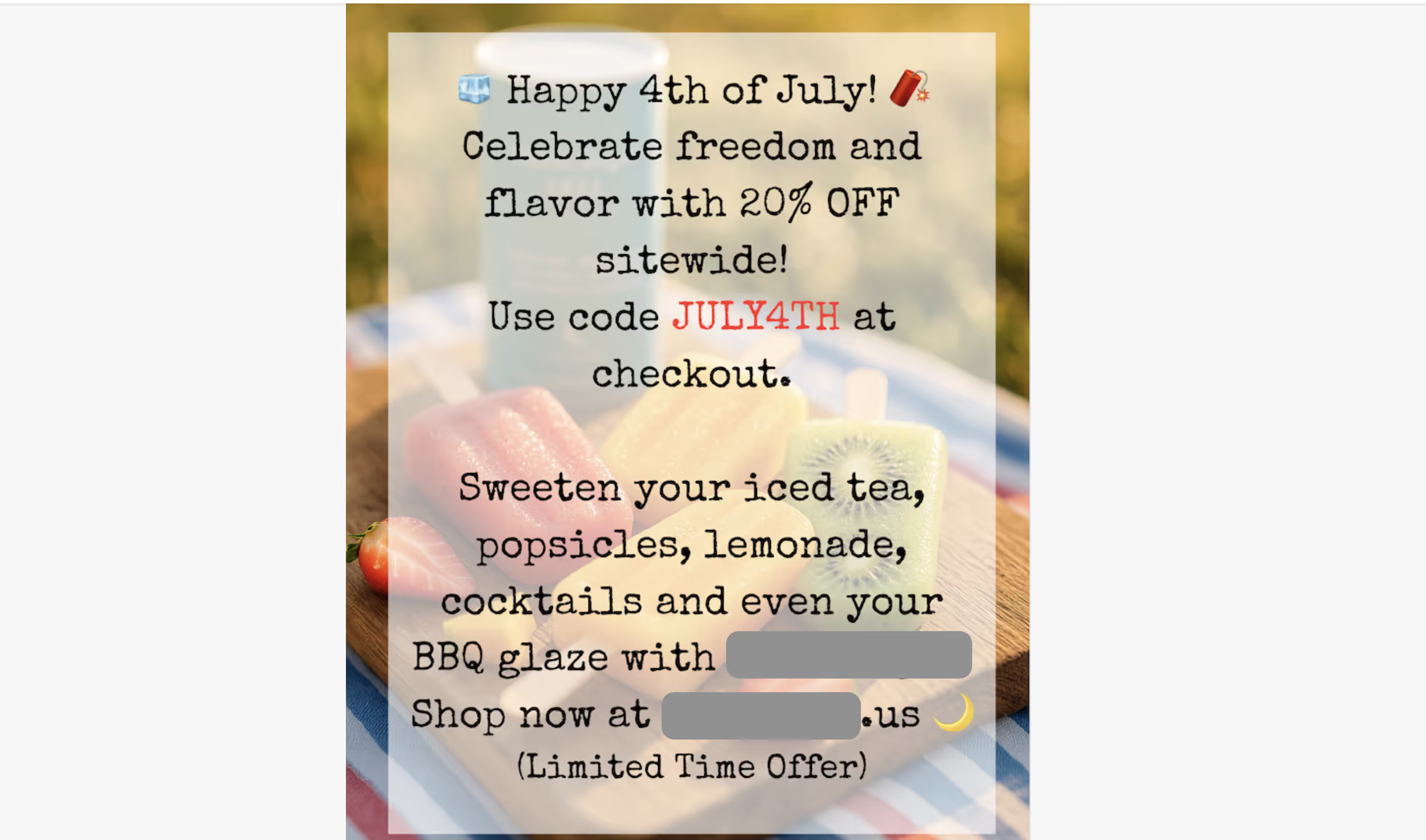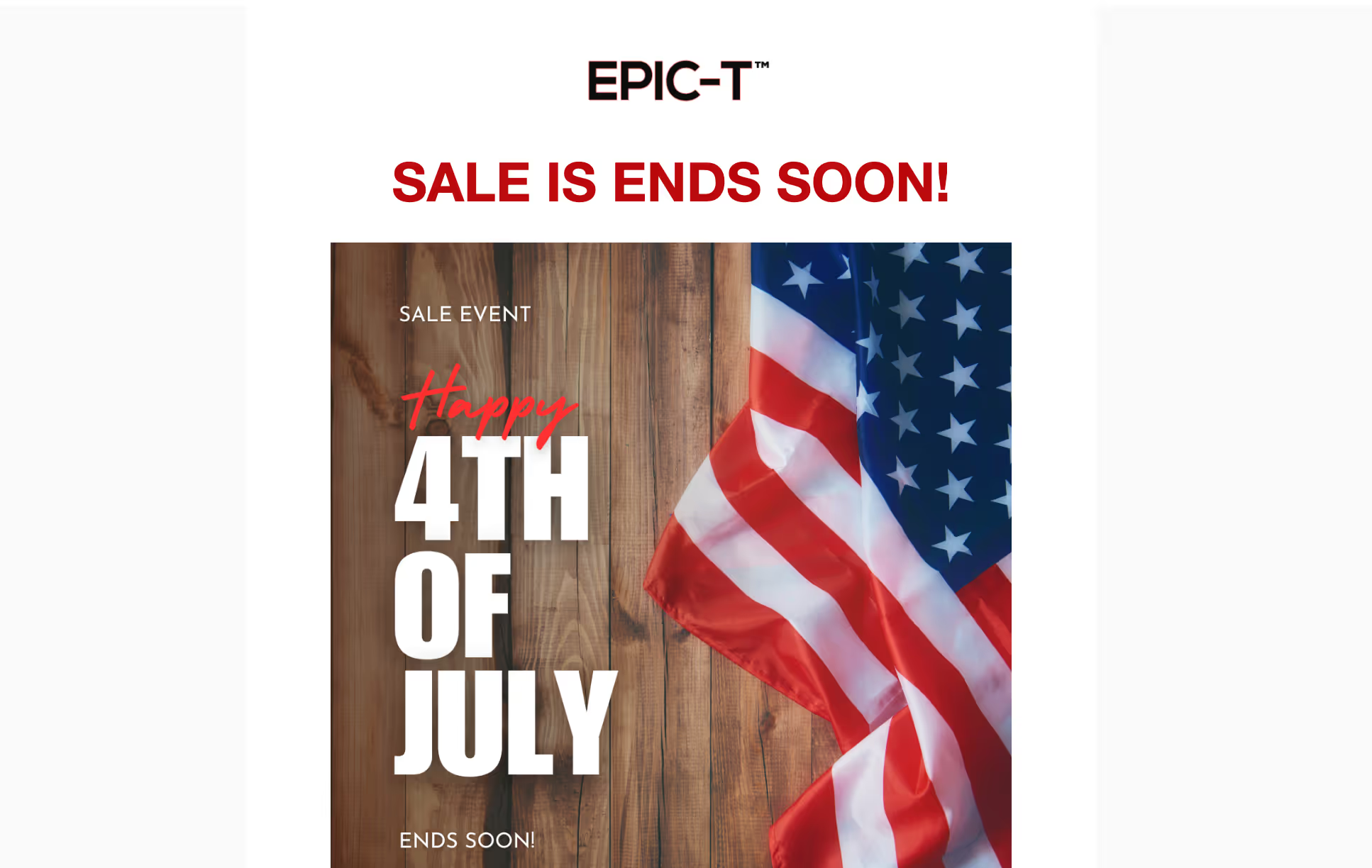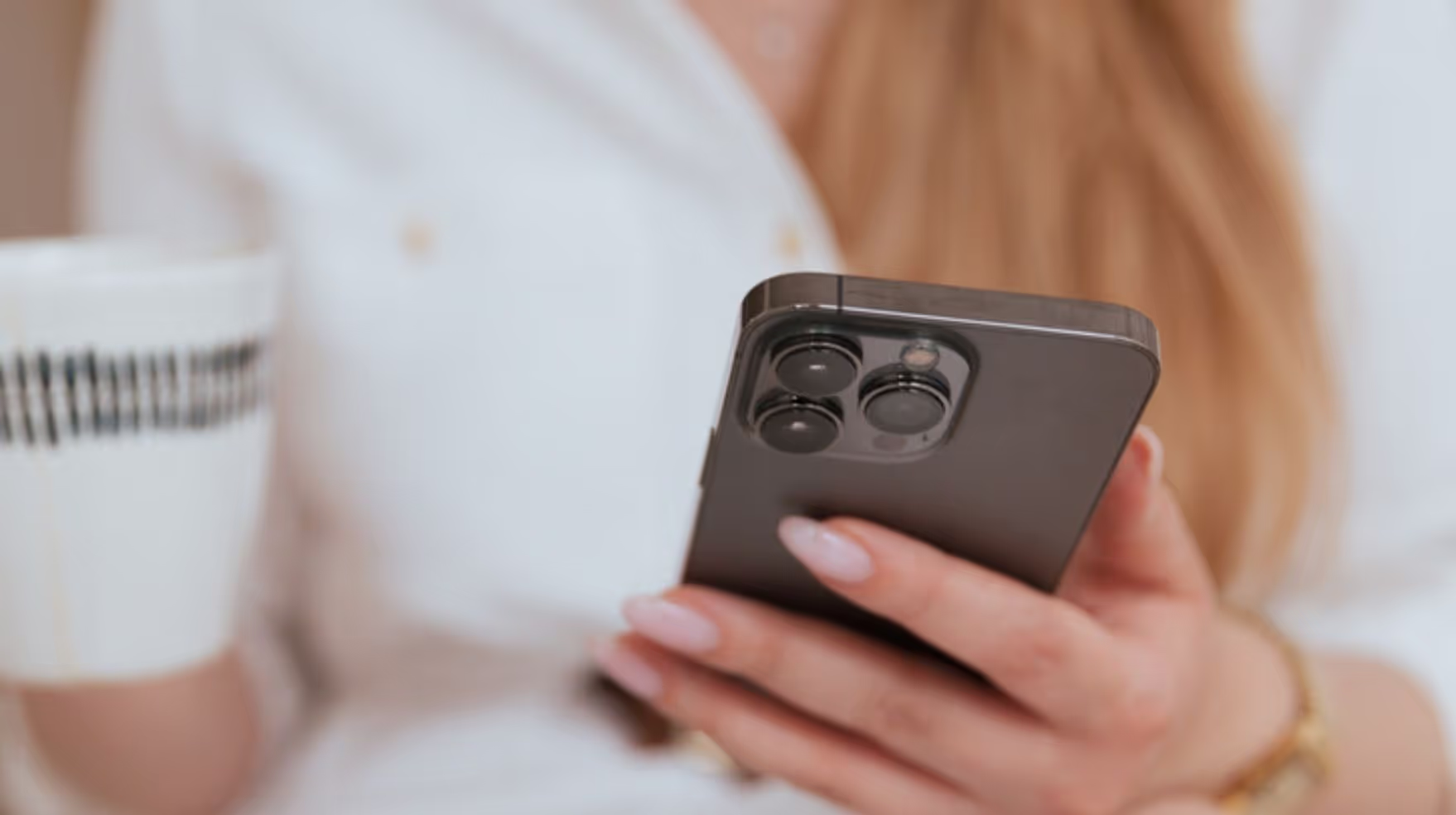The 4th of July represents one of the most lucrative opportunities in the email marketing calendar. In 2024, Americans spent an estimated $15.5 billion on Independence Day celebrations, with consumers actively seeking deals and promotions during this patriotic shopping spree. Yet despite this massive opportunity, countless brands stumble with their 4th of July email marketing campaigns, leaving money on the table and damaging their sender reputation.
As a marketing agency that analyzes thousands of holiday email marketing campaigns annually, we've witnessed some spectacular Independence Day email fails firsthand, including several wellness brands that made critical sales mistakes in their recent wellness email campaigns.
Here's what went wrong in 2025's campaigns and how to improve 4th of July email campaigns for wellness brands to avoid these costly mistakes.

This subject line violates fundamental neuro-marketing principles by creating negative emotional associations. The word "begged" implies desperation and puts the customer in a subservient position, the exact opposite of what you want in premium wellness email campaigns.
Using accusatory language like "you begged" triggers defensive psychological responses. Instead of feeling valued, customers feel judged. This approach damages brand perception and creates negative neural pathways associated with your brand, a critical mistake in holiday email marketing.
What They Should Have Said: "By popular demand: 40% off extended" or "You asked, we listened: Sale extended"
This subject line violates fundamental neuro-marketing principles by creating negative emotional associations. The word "begged" implies desperation and puts the customer in a subservient position, the exact opposite of what you want in premium wellness email campaigns.
Using accusatory language like "you begged" triggers defensive psychological responses. Instead of feeling valued, customers feel judged. This approach damages brand perception and creates negative neural pathways associated with your brand, a critical mistake in holiday email marketing.
What They Should Have Said: "By popular demand: 40% off extended" or "You asked, we listened: Sale extended"
All mentions are of "expires tonight," "ends at midnight," or "last chance" without specifying time zones.

The US spans nine time zones, making "midnight" meaningless without clarification. Let’s also include overseas customers who are looking for great deals; this makes the confusion even more challenging.
This creates:
1. Confusion about when the offer actually ends
2. Frustration when customers miss deadlines due to unclear timing
3. Lost sales from customers who assume they've missed the deadline.
Many emails said "Ends At Midnight" but provided no timezone reference anywhere in the email, not even in the footer. However, some of the email campaigns had no timeline at all.

Solution: Always specify time zone ("11:59 PM EST") or use countdown timers that automatically adjust to the recipient's location in your wellness email campaigns.
None of the wellness brands we analyzed used countdown timers despite having "limited time" offers.
Countdown timers trigger the brain's scarcity detection system, activating loss aversion, one of the most powerful psychological motivators. Without visual urgency cues, "ends tonight" becomes just words on a screen. This is a common oversight in holiday email marketing mistakes.

What High-Converting Emails Do:
✓ Dynamic countdown timers showing hours/minutes remaining
✓ Progress bars showing limited inventory
✓ Visual urgency indicators (red text, warning icons)
✓ Specific end times with timezone clarity
Examples: "There is still time to save for 4th Of July" (inconsistent capitalization) and "SALE IS ENDS SOON!" (grammatical error)

These fundamental language errors signal unprofessionalism and lack of attention to detail. Why capitalize "Of" but not "time"? How does a sale simultaneously "is" and "ends"? These inconsistencies create cognitive dissonance and suggest poor quality control, particularly damaging for wellness email campaigns where trust is everything.
Our brains are pattern-recognition machines that instantly detect inconsistencies. When customers see basic grammar mistakes, spelling errors, or random capitalization, the brain's pattern recognition system raises red flags about brand reliability. If they can't proofread a simple email, can they be trusted with product quality, shipping, or customer service?

Choose one style guide and stick to it consistently. According to research by Tidio, 97% of people say grammar mistakes influence their perceptions of companies and individuals. Specifically, 52% stated that grammar usage influences their perception of a company's professionalism, and 35% reported that it affects their perception of a company's credibility. Additionally, a study by Global Lingo found that 59% of people claimed they would not use a website littered with poor grammar.
Our brains are pattern-recognition machines. Inconsistent formatting creates subconscious unease and questions about brand reliability and the product itself. If they can't get basic grammar right, can they be trusted with product quality?
Best Practice: Choose one capitalization style and stick to it. Either "4th of July" or "4th Of July" – never mix both approaches in your 4th of July email marketing.
Many used obvious stock patriotic imagery (flag on wood background) with generic "SALE ENDS SOON!" messaging.
This approach creates no emotional connection beyond basic patriotic symbolism. The messaging feels templated and impersonal, missing opportunities for brand differentiation. But there's a deeper psychological issue at play here in 4th of July email marketing.
When brands rely solely on stock images and avoid showing their actual products in authentic settings, they unknowingly trigger consumer skepticism.
According to neuro-marketing research by Dr. Antonio Damasio, purchasing decisions are made in the limbic brain, the emotional center that processes signals related to trust. Stock imagery sends a subconscious message of inauthenticity.
According to a survey by MDG Advertising, 67% of online shoppers prioritize high-quality images when making purchase decisions. Additionally, research shows that consumers are "flat out ignoring stock imagery photos they see online" because "stock photos look fake and they reduce trust from onlookers". When customers can't see real product photography – especially unretouched, authentic shots – the brain's pattern recognition system raises red flags: "If they can't show me the real product without Photoshop, how can I trust this is legitimate?"
Many wellness brands, especially smaller ones, believe they can't afford professional product photography, this is a critical strategic error. The human brain processes visual information 60,000 times faster than text, and authentic product imagery is often the difference between conversion and abandonment in wellness email campaigns.



As part of our comprehensive email marketing packages, we include professional brand photography shoots that capture your products authentically. We also offer standalone product photography projects for brands who want to elevate their visual storytelling. Because in wellness marketing, trust isn't just important, it's everything.
Schedule a call with us today to boost your next sale!

Based on cognitive psychology research, here's what language triggers positive responses in holiday email marketing campaigns:
Power Words That Create Action:
✓ "Exclusively" (triggers VIP feelings)
✓ "Limited" (activates scarcity response)
✓ "Unlock" (suggests gaining access)
✓ "Celebrate" (positive emotional association)
Words to Avoid:
✓ "Begged" (creates shame/defensiveness)
✓ "Last chance" without specifics (feels manipulative)
✓ "Hurry" without context (creates anxiety)"Don't miss" (negative framing)
Timing Language That Works:
✓ "24 hours remaining" (specific and clear)
✓ "Ends Tuesday at 11:59 PM EST" (eliminates confusion)
✓ "While supplies last" (scarcity without pressure)

Credit: Lemme's 4th of July, 2025, email campaign
The wellness brands that succeed during 4th of July campaigns understand that their audience values:
✓ Authenticity over aggressive sales tactics
✓ Clear, honest communication
✓ Alignment between holiday messaging and brand values
✓ Respect for customer intelligence
The Countdown Timer Strategy
High-converting wellness brands use countdown timers because they:
✓ Create visual urgency without seeming desperate
✓ Work across all time zones automatically
✓ Trigger immediate action responses
✓ Can be branded to match your aesthetic
The Value-Alignment Approach
Instead of generic patriotic messaging, successful wellness email campaigns connect July 4th themes to their core values:
✓ Freedom from toxic ingredientsIndependence from big pharma
✓ Natural celebration of American-made products
✓ Family wellness traditions
The Hidden Psychology of Holiday Email Timing
Our analysis shows that sending "final hours" emails creates different psychological responses depending on timing:
✓ 24+ hours before deadline: Builds anticipation
✓ 12-24 hours: Creates gentle urgency
✓ Final 6 hours: Triggers loss aversion
✓ Final hour: Can feel manipulative if overused
Pro Tip: The most successful campaigns use a sequence: announcement → reminder → final hours, with different psychological triggers at each stage.


The wellness brands that failed this 4th of July made the same critical mistake: they prioritized quick sales tactics over customer psychology and brand integrity.
The most successful wellness email campaigns understand that wellness customers are sophisticated, value-driven consumers who respond to authenticity, clarity, and respect.
The Real Cost of These Mistakes:
✓ Damaged brand perception
✓ Decreased customer lifetime value
✓ Poor email deliverability from high unsubscribe rates
✓ Lost sales from confused or frustrated customers
Ready to create holiday email marketing campaigns that actually convert? Our team specializes in neuro-marketing strategies that honor your customers' intelligence while driving real results. We've helped wellness brands increase their holiday email revenue by an average of 186% through psychologically-informed campaign strategies.
Contact us to discover how we can help your brand avoid these common holiday email marketing mistakes and develop campaigns that foster both sales and brand loyalty.